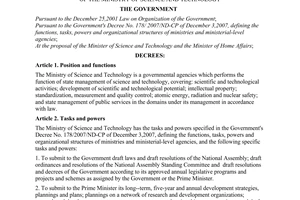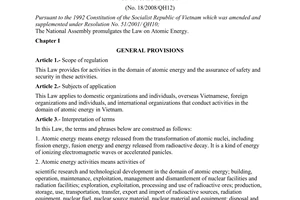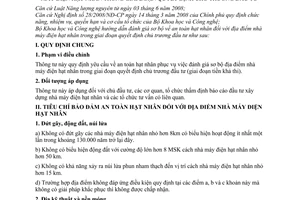Nội dung toàn văn Circular No. 13/2009/TT-BKHCN of May 20, 2009, guiding preliminary nuclear safety evaluation of sites of nuclear power plants at the stage of investment decision.
|
THE
MINISTRY OF SCIENCE AND TECHNOLOGY |
SOCIALIST
REPUBLIC OF VIET NAM |
|
No. 13/2009/TT-BKHCN |
Hanoi, May 20, 2009 |
CIRCULAR
GUIDING PRELIMINARY NUCLEAR SAFETY EVALUATION OF SITES OF NUCLEAR POWER PLANTS AT THE STAGE OF INVESTMENT DECISION
THE MINISTRY OF SCIENCE AND TECHNOLOGY
Pursuant to the June 3, 2008
Law on Atomic Energy;
Pursuant to the Government's Decree No. 28/ 2008/ND-CP of March 14. 2008.
defining the functions, tasks, powers and organizational structure of the
Ministry of Science and Technology;
The Ministry of Science and Technology guides the preliminary nuclear
safety evaluation of sites of nuclear power plants at the stage of investment
decision as follows:
I. GENERAL PROVISIONS
1. Scope of regulation
This Circular prescribes nuclear safety requirements for the preliminary evaluation of sites of nuclear power plants at the stage of investment decision (pre-feasibility study stage).
2. Subjects of application
This Circular applies to investors, agencies and organizations evaluating reports on investment in building nuclear power plants and relevant consulting organizations.
II. NUCLEAR SAFETY CRITERIA FOR SITES OF NUCLEAR POWER PLANTS
1. Faults, earthquakes, volcanoes
a/ There was no fault which is less than 8 km from a nuclear power plant and shows signs of activity at least once within the last 130.000 years.
b/ There is no presage of an earthquake of a magnitude higher than 8 on the MSK scale and less than 50 km from a nuclear power plant.
c/ There is no possibility of eruption of a volcano emitting lava to areas less than 15 km from a nuclear power plant.
d/ A site that fails to satisfy the conditions specified at Points a. b and c of this Clause and has no remedy will not be accepted.
2. Geo-techniques and foundations
a/ The foundation of a reactor or turbine house must be based on a relatively monolithic bedrock which is solid and resistant to disruption, vigorous cracking or weathering.
b/ The foundations of other facilities of a nuclear power plant must not be based on weak, liquefiable or highly expansible soil or soil which can magnify vibratory motion.
c/ A site that fails to satisfy the conditions specified at Points a and b of this Clause and has no remedy will not be accepted.
3. Extreme meteorological phenomena
a/ No extreme meteorological phenomenon with a wind speed of more than 300 km/h in the proposed site of a nuclear power plant occurred within the last 100 years.
b/ A site that fails to satisfy the condition specified at Point a of this Clause and has no remedy will not be accepted.
4. Inundation and flooding
a/ The proposed site of a nuclear power plant was not inundated or flooded or hit by a flash flood within the last 100 years and it is forecast that it will not be inundated, flooded or hit by a flash flood during the whole operation cycle of the plant.
b/ A site that fails to satisfy the condition specified at Point a of this Clause and has no remedy will not be accepted.
5. Impacts of human activities on nuclear power plants
a/ The distance from a nuclear power plant to a defense work, military zone, road, fuel pipeline or establishment storing or using flammable or explosive materials must be long enough to keep the pressure caused by a possible fire or explosion on the nuclear power plant at 0.07 bar (7 kPa) or below.
b/ The distance from a nuclear power plant to an airfield must be at least 7 km.
c/ A site that fails to satisfy the conditions specified at Points a and b of this Clause and has no remedy will not be accepted.
6. Impacts of radiation on local inhabitants
a/ The proposed site of a nuclear power plant must satisfy the following conditions in order to minimize impacts of radiation on local inhabitants:
b/ A restricted area must be demarcated with its outer boundaries at least 1 km away from the fence of the plant. In case a person at a position more than 1 km away from the fence of the plant may be exposed to a total effective dose equivalent of irradiation exceeding 0.25 sievert (25 rem) or a total iodine radioactive contamination of his/her thyroid exceeding 3 sieverts (300 rem) within 2 hours after the occurrence of an incident, the restricted area must be expanded to that position;
- A limited-entry area must be demarcated surrounding the restricted area with a person at its outer boundaries exposed to a total effective dose equivalent of irradiation not exceeding 0.25 sievert (25 rem) or a total iodine radioactive contamination of his/her thyroid not exceeding 3 sieverts (300 rem) during the time a radioactive cloud passes by. The dose of collective irradiation for the limited-entry area must not exceed 20,000 people x sievert upon the occurrence of an incident.
b/ In case impacts on local inhabitants exceed the level specified at Point a of this Clause and there is no remedy, the site of a nuclear power plant will not be accepted.
7. Cooling water and power supply for the operation of a plant
a/ The site of a nuclear power plant must have sufficient cooling water supply and the power supply for the plant's operation must be uninterrupted in any circumstance.
b/ A site that fails to satisfy the condition specified at Point a of this Clause and has no remedy will not be accepted.
III. REQUIREMENTS ON SITE SURVEY AT THE INVESTMENT REPORTING STAGE
1. Faults, earthquakes and volcanoes
Survey of faults, signs of an earthquake and volcano eruption which may affect the safety of a nuclear power plant shall be conducted in the following aspects:
a/ Survey of geological and tectonic conditions of the area on a scale of 1:500.000 within a radius of 150 km and on a scale of 1:50.000 within a radius of 25 km from a nuclear power plant: classification of active faults based on geological, geophysical, topographical and seismic documents. A fault is considered active if it showed signs of motion within the last 1.8 million years or has a structural connection with another known active fault;
b/ Collection and summing up of seismic data; identification of the risks of earthquake based on evaluating the seismic and tectonic conditions of the area;
c/ Identification of the risks of earthquake-induced vibratory ground motion based on tectonic characteristics of the area and specific data of the site.
2. Geo-techniques and foundations
Survey of geotechnical characteristics and foundations, and projection of the geotechnical cross-sections of the site of a nuclear power plant shall be conducted to determine the following:
a/ Possibility of landslides, rock slips, erosion of river banks, coasts or mountain slopes in the proposed site and its surrounding area;
b/ Possibility of ground elevation, subsidence or collapse in the proposed site, based on available geological maps and documents, paying attention to caves, grottos, mine pits, wells and drilling holes;
c/ Possibility of ground liquefaction, based on parameters and typical vibratory ground motion values;
d/ Physico-mechanical characteristics of the ground and foreign objects therein: stability of the ground under the effects of static and dynamic load;
dd/ Movement and physico-chemical characteristics of ground water.
3. Meteorological and hydrological phenomena
a/ Survey and forecast of impacts of natural disasters (wind. rain, typhoon, sandstorm, tsunami, change of temperature, lightning, tornadoes) on the site. Forecast of impacts of these natural disasters when they occur concurrently, especially in the context of climate change.
b/ Survey and forecast of meteorological and hydrological phenomena which may cause radioactive radiation or convergence with potential harmful impacts exceeding the limits permitted for humans and the environment in the site and surrounding area of a nuclear power plant.
4. Inundation and flooding
Comprehensive survey of causes of floods such as dike or dam rupture, heavy rain, storm, tsunami, earthquake or other geological phenomena shall be conducted in the following aspects:
a/ Survey and forecast of headwater floods, risks of dike or dam damage or rupture, accumulation of mud and sand, or lakebed slide. Analysis of adverse impacts based on the assumption of dike or dam rupture by causes and severity of flooding and runoff speed and flow;
b/ Survey of river and stream flow changes caused by natural forces. Forecast of the risks danger of flood caused by tributary currents. Collection of hydrological information and charts, including current parameters, flood peak flow, total flow of a flood cycle, flow and water level fluctuations, and current speed. Determination of stability of channels, deposit transport and precipitations in the area;
c/ Collection of historical information on tsunami which may cause flooding in the proposed site. Survey of causes of tsunami such as seabed movement, landslide and undersea volcanic eruption. Survey of wave heights, lengths and directions, and reaction of onshore waters. Survey of flood levels and flooded areas, adverse impacts of bank erosion and landslide upon tsunami run-up;
d/ Forecast of floods caused by other phenomena and study of possible damage caused by flood.
5. Impacts of human activities on nuclear power plants
Survey of human activities which may cause unsafety to the operation of a planned nuclear power plant shall be conducted, covering the following jobs:
a/ Collection and survey of information on hazardous, flammable, explosive, corrosive or toxic materials in storage, transportation and use, military drills and fuel pipelines;
b/ Survey of warehouses, wharves, storing yards and mineral-exploiting and storing places where water flow is temporarily blocked, causing inundation, flooding or ground subsidence;
c/ Survey of locations of airfields, kinds of airplanes, flight routes and frequency;
d/ Survey of road, waterway and sea transport routes, including means of transport, transportation frequency and characteristics, ports, landings, stops, terminals, paying attention to crowded traffic routes and crossings.
6. Impacts of radiation on local inhabitants
To survey the following:
a/ Population distribution and density and forecast population change in the area;
b/ Ways of radioactive material spreading and fallout in the air and water, based on meteorological parameters (wind directions and speed, air disturbance, humidity, rainfall, solar radiation) or hydrological parameters (river, stream, surface and ground water characteristics), topographical characteristics (mountains, valleys) and impacts of big construction works;
c/ Background radiation and irradiation dose for local population;
d/ Possible radiation risks to people which serve as a basis for working out plans on response to incidents, paying attention to the local land use planning, water and food sources;
dd/ Conditions for building the road system for evacuation, food and foodstuff supply, and flexible infrastructure for people in evacuation areas;
e/ Conditions and places for setting up an emergency response center outside the nuclear power plant;
g/ Site suitability to the potential socio-economic development of the area (commerce, industry and tourism) and risks caused by the plant on the area as well as impacts of activities in the area on the plant.
7. Cooling water and power supply for the operation of nuclear power plants
To survey the following:
a/ Conditions for building of cooling water supply systems and power supply for the operation of the nuclear power plant:
b/ Risks caused by natural elements and human activities on cooling water supply and power supply for the operation of the nuclear power plant.
IV. ORGANIZATION OF IMPLEMENTATION
1. This Circular takes effect on July 6. 2009.
2. Any problem or difficulty arising in the course of implementation should be reported to the Ministry of Science and Technology for timely settlement.-
|
|
FOR
THE MINISTER OF SCIENCE AND TECHNOLOGY |


